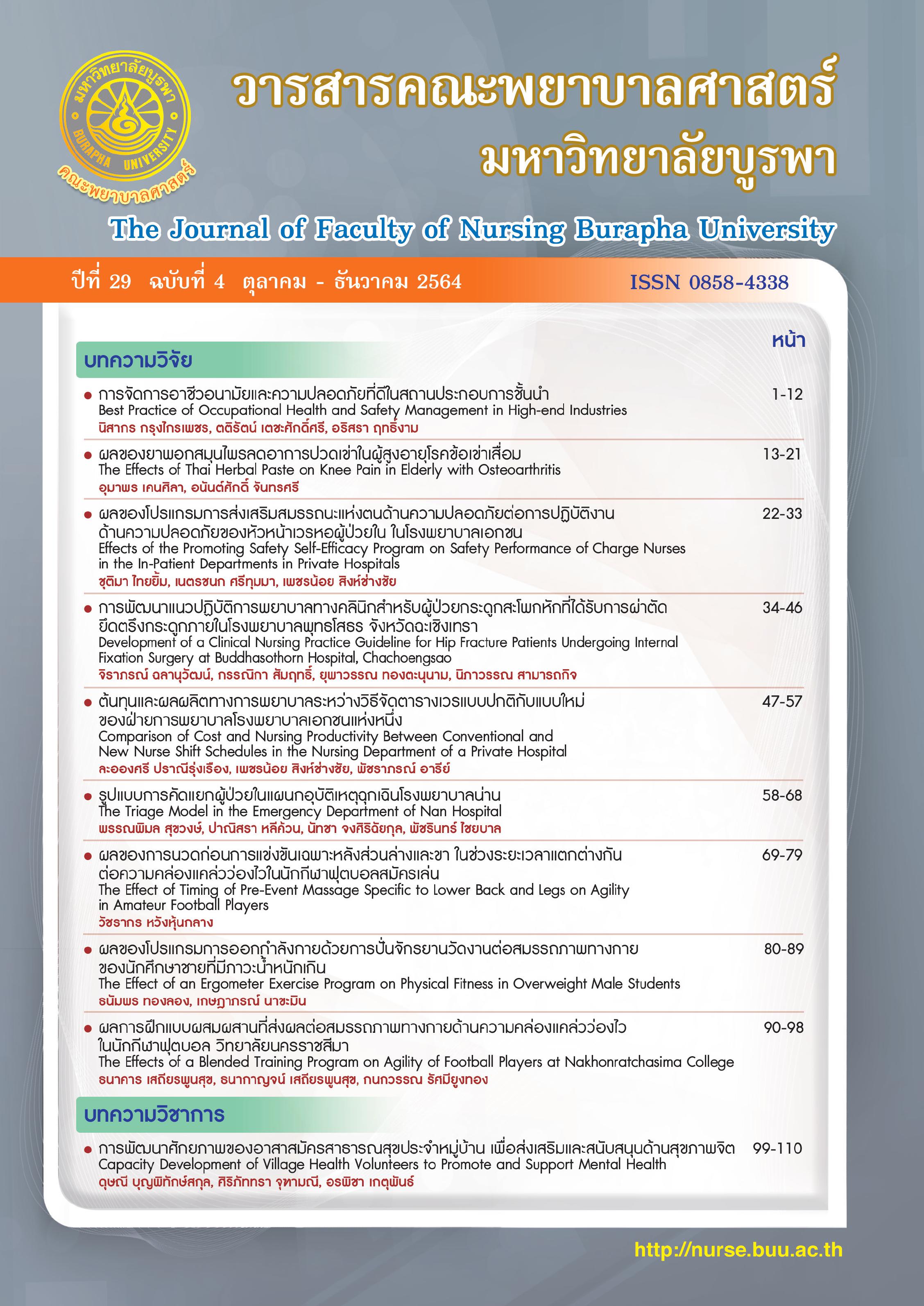ผลของโปรแกรมการส่งเสริมสมรรถนะแห่งตนด้านความปลอดภัย ต่อการปฏิบัติงานด้านความปลอดภัยของหัวหน้าเวรหอผู้ป่วยใน ในโรงพยาบาลเอกชน
คำสำคัญ:
สมรรถนะแห่งตน, การปฏิบัติงานด้านความปลอดภัย, หัวหน้าเวร, โรงพยาบาลเอกชนบทคัดย่อ
การวิจัยแบบกึ่งทดลองครั้งนี้เพื่อศึกษาผลของโปรแกรมการส่งเสริมสมรรถนะแห่งตนด้านความปลอดภัยต่อการปฏิบัติงานด้านความปลอดภัยของหัวหน้าเวรหอผู้ป่วยใน ในโรงพยาบาลเอกชน กลุ่มตัวอย่างคือพยาบาลหัวหน้าเวร หอผู้ป่วยใน ในโรงพยาบาลเอกชน จำนวน 60 คน แบ่งเป็นกลุ่มทดลอง 30 คน กลุ่มควบคุม 30 คน โดยใช้วิธีสุ่มตัวอย่าง แบบง่าย เครื่องมือที่ใช้ในการวิจัย โปรแกรมการส่งเสริมสมรรถนะแห่งตนด้านความปลอดภัย และแบบสอบถามการปฏิบัติงานด้านความปลอดภัย วิเคราะห์ข้อมูลด้วยสถิติเชิงพรรณนาและการทดสอบที
ผลการวิจัยพบว่า กลุ่มทดลองมีค่าคะแนนเฉลี่ยของการปฏิบัติงานด้านความปลอดภัยหลังเข้าร่วมโปรแกรมอยู่ในระดับสูง (x ̅ = 4.47, SD = .34) ส่วนกลุ่มควบคุมมีค่าคะแนนเฉลี่ยอยู่ในระดับปานกลาง (x ̅ = 3.47, SD = .52) และพบว่าค่าเฉลี่ยคะแนนการปฏิบัติงานด้านความปลอดภัยของกลุ่มทดลองหลังเข้าร่วมโปรแกรมการส่งเสริมสมรรถนะแห่งตนด้านความปลอดภัยสูงกว่ากลุ่มควบคุมอย่างมีนัยสำคัญทางสถิติ (p < .05) และพบว่าคะแนนเฉลี่ยการปฏิบัติงานด้านความปลอดภัยของกลุ่มทดลองหลังการใช้โปรแกรมการส่งเสริมสมรรถนะแห่งตนด้านความปลอดภัยสูงกว่าก่อนการ ใช้โปรแกรม (p < .05) การวิจัยนี้ชี้ให้เห็นว่า โปรแกรมส่งเสริมสมรรถนะด้านความปลอดภัยพัฒนาการปฏิบัติงานของหัวหน้าเวรได้ ผู้บริหารควรนำโปรแกรมส่งเสริมสมรรถนะแห่งตนไปพัฒนางานด้านความปลอดภัย
เอกสารอ้างอิง
Best, J. W. & Kahn, J. V. (2014). Research in education (10th ed.). Harlow: Pearson Education.
Chanpilom, N. (2017). The effect of self-efficacy promotion program on the ability to give emergency medical services of emergency medical volunteers. Nursing and Health Journal, 12(1), 25-35. (in Thai)
Chantiya, S., Singchangchai, P., Aree, P. (2019). Leadership in safety and safety practices in health organizations: A systematic review of the literature. Uttaradit Boromarajonani College of Nursing Journal, 11, 1-15. (in Thai)
Charoenboon, W., Ujaratana, P., & Suwankot, K. (2016). The results of the program for preparing to be a head nurse in a tertiary care hospital under the Department of Medical Services. Ministry of Public Health. Nakhon Ratchasima College Journal, 10(2), 111-124. (in Thai)
Deepaisansakul, P. (2015). Strategies for the development of private hospitals towards good governance. Veridian E-Journal, Silpakorn University, 8, 229-232. (in Thai)
Dehghani, F., Maasoumeh, B., Maryam & Hossein, F. (2020). Effect of palliative care training on perceived self-efficacy of the nurses. BMC Palliat Care, 19(63), 1-6. doi.org/10.1186/s12904-020-00567-4
Dein, N. (2018). Effectiveness of the nursing risk management system at hospitals: One of the private sectors in Pathum Thani province. Charoenkrung Pracharak Hospital Journal, 14(2), 11-24. (in Thai)
Griffin, M. A., & Neal, A. (2000). Perception of safety at work: A framework for linking safety climate to safety performance, knowledge, and motivation. Journal of Occupational Health Psychology, 5(3), 347-358.
Ketwathimart, M., Phulom, N., Chuencham, J. & Punpom, C. (2016). Developing a model to promote competency in risk management and safety in patient care of nursing students at Boromarajonani College of Nursing, Saraburi. Nursing and Education Journal, 9(4), 74-89. (in Thai)
Kim, H., & Han, S. (2019). Mediating effects of self-efficacy between calling and nursing rofessionalism for nurses in general hospitals. Journal of Korean Academy of Nursing Administration, 25(3), 220-228. doi.org/10.11111/jkana.2019.25.3.220
Lau, R., Willetts, G., Hood, K., & Cross, W. (2015). Development of self-efficacy of newly graduated registered nurses in an aged care program. Australasian Journal on Ageing, 34(4), 224-228. doi.org/10.1111/ajag.12156
National Health Security Office. (2011). Universal health coverage creation report. Bangkok: Arun Printing. (in Thai)
Nuengsittha, W., Tangcharoenkul, P., & Apichatabutr, K. (2018). Situational analysis of patient safety management. surgery intensive care unit Phutthachinraj hospital, Phitsanulok. Phrae Hospital Journal, 26(1), 47-60. (in Thai)
Phupirom, W., Cheykan, W., & Chanthavee, N. (2018). The results of the promotion program: Self-efficacy towards the ability of professional nurses to collect blood samples for culture testing and the rate of microbial contamination. Medicine District11 Journal, 32(3), 1189-1198. (in Thai)
Raica, D. A. (2009). Effect of action-oriented communication training on nurses’ communication self-efficacy. Medsurg Nursing, 18(6), 343-360.
Reason, J., Hollnagel, E., & Paries, J. (2006). Revisiting the Swiss cheese model of accidents. France: Eurocontrol Experimental Centre Note No. 13/06.
Sangsuwan, J., Boonyaleephan, S., Siripanichsakun, K., Chaisit, Y., Pholputtha, L. & Duangmala, M. (2016). Factors predicting self-efficacy in Labor-aged AIDS patients receiving antiretroviral therapy. Nursing Journal, 43, 84-94. (in Thai)
The Healthcare Accreditation Institute (Public Organization). (2019). Documents for the 20th HA national forum: Change & collaboration for sustainability. Bangkok: Healthcare Accreditation Institute. (in Thai)
Thinkham, N., Pensirinapha, N., & Prasertchai, A.(2014). Safety culture in patient care among personnel working in a private hospital in Bangkok. Safety and Health Journal, 7: 65-67. (in Thai)
World Health Organization [WHO]. (2015). Patient safety. Retrieved from http://www.jointcommission.org/standards_information/npsgs.aspx





